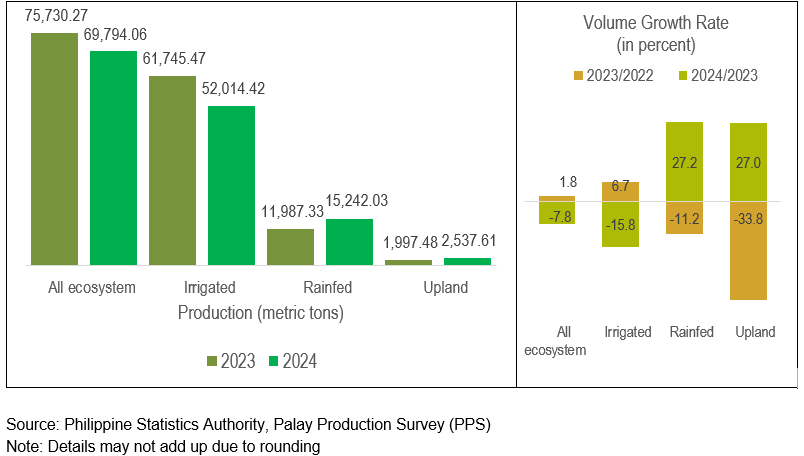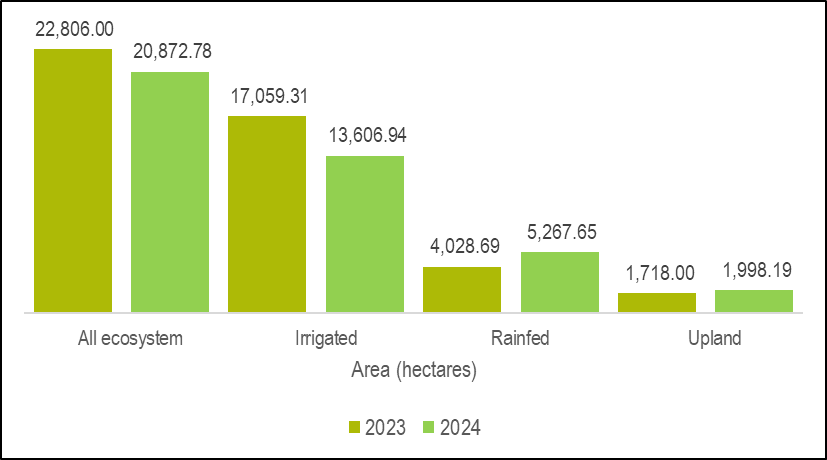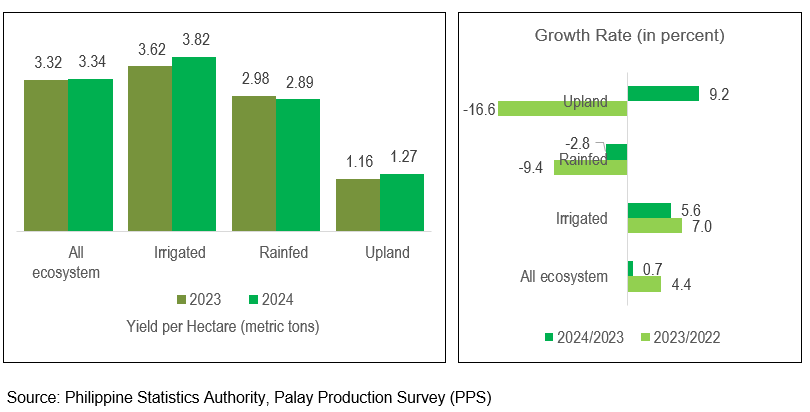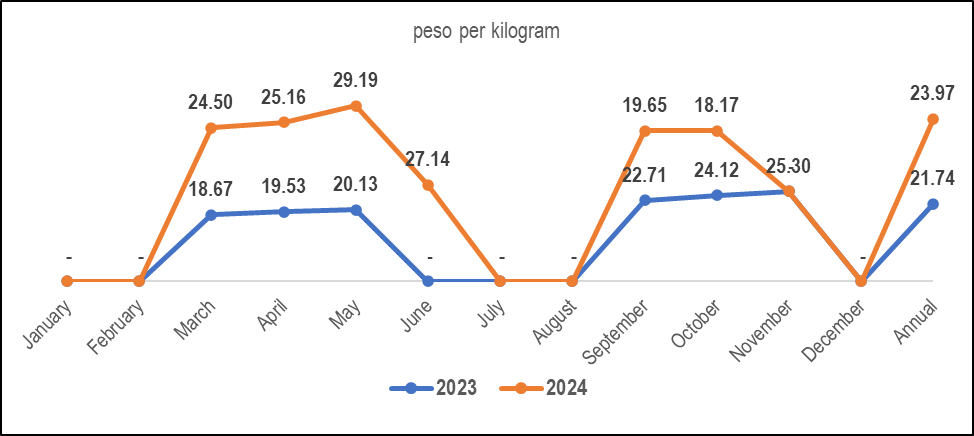Palay production down by 7.8 percent
The annual volume of palay production in 2024 was recorded at 69,794.06 metric tons, a downtrend by 7.8 percent from the 75,730.27 recorded a year earlier. Of the total palay output, a rebound growth in production volume of rainfed and upland were recorded at 27.2 percent and 27.0 percent, respectively, compared with their respective 2023 growth rate of -11.2 percent and -33.8 percent. By contrast, the quantity of production from irrigated farms decreased to 52,014.42 metric tons or by 15.8 percent, from its previous year output of 61,745.47 metric tons. (Figure 1 and Table 1)
Figure 1. Volume of Palay Production and Growth Rate, by Ecosystem
Apayao Province, Cordillera Administrative Region
January - December: 2023 – 2024
 Figure 2. Percent Share by Ecosystem to Total Palay Production
Figure 2. Percent Share by Ecosystem to Total Palay ProductionApayao Province, Cordillera Administrative Region
January - December: 2023 – 2024

Source: Philippine Statistics Authority, Palay Production Survey (PPS)
In 2024, nearly three-fourth of the province’ palay production was produced from irrigated farms, while more than a quarter came from rainfed and upland combined. (Figure 2 and Table 1)
The aggregate harvest area contracted to 20,872.78 hectares or 8.5 percent, from the 22,806 hectares record in 2023. By type of ecosystem, an increment in rainfed and upland harvest area were recorded at 30.8 percent and 16.3 percent, respectively, from their levels a year back. On the other hand, irrigated harvest area further declined to 20.2 percent year-on-year. (Figure 3 and Table 1)
Figure 3. Palay Harvest Area, by Ecosystem, Apayao Province
Cordillera Administrative Region, January - December: 2023 – 2024
 Source: Philippine Statistics Authority, Palay Production Survey (PPS)
Source: Philippine Statistics Authority, Palay Production Survey (PPS)Figure 4. Palay Yield per Hectare and Annual Growth Rate, by Ecosystem
Apayao Province, Cordillera Administrative Region
January- December: 2023 – 2024

The 2024 yield for all ecosystems combined was posted at 3.34 metric tons per hectare. This was slightly higher by 0.7 percent from year-ago yield of 3.32 metric tons. Irrigated palay was registered at 3.82 metric tons and upland palay at 1.27 metric tons, or 5.6 percent and 9.2 percent higher than their respective levels in 2023. Rainfed, on the other hand, decreased to 2.89 metric tons, or 2.8 percent below previous year level. (Figure 4 and Table 1)
From January to December 2024, the average monthly farmgate prices of palay ranged from PhP18.17 to PhP29.19 per kilogram with PhP23.97 annual average, higher by 10.3 percent from PhP21.74 per kilogram recorded in 2023. The highest and lowest quotations were registered in May and October, respectively. (Figure 5 and Table 2)
Figure 5. Average Farmgate Prices of Palay (Dry), Apayao Province
Cordillera Administrative Region, January- December: 2023 – 2024

Source: Philippine Statistics Authority, Farm Prices Survey (FPS)
Table 1. Palay Volume of Production, Harvest Area, Yield per Hectare,
Year-on-Year Change, and Percent Share by Ecosystem
Apayao Province, Cordillera Administrative Region
January - December: 2023 – 2024
(in metric tons and hectares)
 Source: Philippine Statistics Authority, Palay Production Survey (PPS)
Source: Philippine Statistics Authority, Palay Production Survey (PPS)Note: Details may not add up due to rounding
Table 2. Annual and Monthly Average Farmgate Prices of Palay (Dry), Growth Rate Apayao Province, Cordillera Administrative Region, and Philippines, 2023-2024
(peso per kilogram)

Source: Philippine Statistics Authority, Farm Prices Survey (FPS)
Note: Dash (-) means no trading captured / not applicable
TECHNICAL NOTES
The Palay Production Survey is one of the major agricultural surveys conducted by the Philippine Statistics Authority. This generates estimates on palay production, area, yield, and other production-related data that serve as inputs for policy making and programs on palay/rice. Specifically, the production data generated from the survey are direct inputs to the Value of Production in Philippine Agriculture and Fisheries and to the computation of Gross Domestic Product, accordingly. The data collection covering each quarter was conducted during the first 10 days of April, July, October, and December.
Crop Production - refers to the quantity produced and actually harvested during the reference period. It includes those harvested but damaged, stolen,given away consumed, given as harvester’s and thresher’s shares, reserved, etc. However, it excludes those produced but not harvested due to low price, lack of demand and force majeure or fortuitous events, etc.
Harvest Area - refers to the actual area from which harvests were realized. This excludes crop area that was totally damaged. It may be smaller than the area planted.
Types of Ecosystems - refers to the type of environment where the palay was planted.
- Irrigated - area with irrigation facilities supplying water through artificial means like gravity, force/power, pump, etc. Irrigated area becomes rainfed only when irrigation system is no longeroperational for the past two (2) years and beyond repair and there is no plan of irrigating the farm.
- Rainfed - palay grownon this ecosystemhas dikes that retain water and is solely dependent upon rainfall for its water supply. Rainfed can be converted to irrigated only if area is laid with permanent irrigation facility.
- Upland - palay grownon this ecosystemdo not have amenities for standing water. It is usually located along elevated lands, along rivers, between hills, but also to low areas having no facilities for standing water. Though crops planted in this type of ecosystem are drought-resistant and do not require standing water for their normal growth, irrigation by flushing is sometimes practiced improving the crops’ performance especially during the long dry spell.
Yield - an indicator of productivity calculated by dividing the production data by the corresponding harvest area.
Metric ton - refers to a unit that is being used which is equal to 1,000 kilograms.
Farmgate Price - refers to the prices received by farmers for the sale of their produce at the first point of sale net of the total marketing cost paid by the farmers. These prices are determined at the farmgate or first point of sale transactions and are also known as “producer prices”.
Approved by:
(sgd)
GEOFFREY B. CALIMUHAYAN
Chief Statistical Specialist
/CBB

